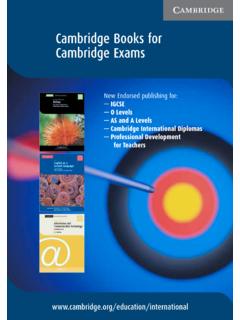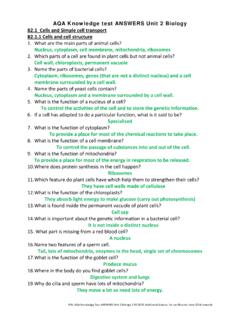Transcription of IGCSE Biology Module One: The Nature and Variety of Living ...
1 IGCSE Biology Module One: The Nature and Variety of Living organisms 1 Lesson Six Human Nutrition Aims By the end of this lesson you should be able to describe the chemical elements and structure of carbohydrates, proteins and lipids, and the tests for glucose and starch identify sources and functions of carbohydrates, proteins, lipids, vitamins A,C & D, the mineral ions calcium and iron, water and dietary fibre understand the processes of ingestion, digestion, absorption, assimilation and egestion, and the role of digestive enzymes in the breakdown of starch, proteins and lipids understand the production, storage and action of bile describe the structure of a villus, and understand how this helps absorption of the products of digestion in the small intestine describe the structures of the human alimentary canal and the functions of the mouth, oesophagus, stomach, small intestine, large intestine and pancreas explain how and why food is moved through the gut by peristalsis *understand the contents of a balanced diet, and *understand that energy requirements vary with age, pregnancy and activity levels Context This lesson covers elements and of Section 2: Structures and functions in Living organisms of the Edexcel specification.
2 Edexcel IGCSE Biology Chapter 4 pages 37 51. Lesson Six Human Nutrition 2 Introduction This lesson is about human food and diet, and about how we process food and extract nutrients from it. In Biology , the term diet means whatever a person eats and drinks. So we are all of us on a diet, even if it is one of cream cakes and fizzy drinks! The term food means any item you might eat or drink, like apple, crisps, lamb, lemonade etc. Most foods are a complex mixture of several different sorts of chemical, each of which is called a nutrient. Nutrients include the carbohydrates, protein and vitamins that you have heard of. Processing food and extracting nutrients from it is the job of the digestive system.
3 This is made up of a long tube called the gut or alimentary canal with extra organs such as the liver and pancreas attached to it - see the diagram on page 47 of Edexcel IGCSE Biology . The Major Nutrients The major groups of nutrients needed in the human diet are as follows: carbohydrates: both starch and sugars are carbohydrates lipids: both fats and oils are lipids proteins vitamins: there are several different vitamins, including vitamin A, vitamin C and vitamin D minerals: more correctly called mineral ions. There are several different mineral ions, including sodium, calcium and iron water dietary fibre: also called roughage. Each of these nutrients is needed for a different reason, so it is not possible to do without one of them by eating more of the rest.
4 IGCSE Biology Module One: The Nature and Variety of Living organisms 3 We will now work through each of these nutrient types in turn. Activity 1 Raid your kitchen cupboard, fridge and freezer and examine the labels on your foods. How many of the major nutrient types are contained in each food you examine? Carbohydrates Structure Carbohydrates are so-called because they contain only three chemical elements: carbon (C), hydrogen (H) and oxygen (O). In the name carbo-hydr-ates : carbo is short for carbon hydr is short for hydrogen ate is used in names of chemical compounds to indicate that they contain oxygen The simplest carbohydrates are called simple sugars. A simple sugar molecule is a single ring of carbon atoms with hydrogen and oxygen atoms attached to them.
5 Glucose, which we have met already, is the most important example. The full structure of a single glucose molecule looks like this notice the ring shape (the six carbon atoms have been numbered 1 to 6): Lesson Six Human Nutrition 4 A glucose molecule However you only need to remember its chemical formula C6H12O6, which tells you the numbers of each sort of atom in the molecule. Activity 2 Count the number of carbon (C), hydrogen (H) and oxygen (O) atoms in the diagram of the glucose molecule. (Hint: There is an extra hydrogen atom on each of carbon atoms 1-5 that has not been drawn in to make the diagram less cluttered.) Verify that there are 6 carbon atoms, 12 hydrogen atoms and 6 oxygen atoms as the chemical formula implies.
6 Fructose (found in grapes) is also a simple sugar. Interestingly, sucrose the chemical name for the sugar you buy from the supermarket - is not a simple sugar. Each sucrose molecule is made of a glucose and a fructose molecule joined together (see figure on page 38 of the textbook). Starch and glycogen molecules are both made of large numbers of glucose molecules joined end to end (see again figure ), so they are sometimes called complex IGCSE Biology Module One: The Nature and Variety of Living organisms 5 carbohydrates . These large molecules are insoluble in water, so they are the forms in which organisms store their glucose for later use. Sources We get our supplies of carbohydrate mainly from plant foods: Rice, wheat, potatoes and other staple foods contain a lot of starch, as do the bread, chips, crisps breakfast cereals and so on which are made from them; Sucrose (ordinary sugar) comes mainly from sugar beet and sugar cane, and is added to many foods to make them sweet.
7 Uses Carbohydrates are mainly used in the body to provide energy, which is released during respiration. The body cannot store much glucose, as it is a soluble and reactive chemical which easily interferes with the rest of the body s chemical reactions. For this reason, spare glucose is converted into glycogen and stored in the muscle and liver cells. Glycogen can rapidly be broken back down to glucose when more of it is needed for respiration: ----------> GLUCOSE GLYCOGEN used in respiration <---------- stored in liver and muscles Once the liver and muscles are filled up with glycogen, any more spare glucose is converted into lipid (fat) and stored under the skin.
8 Tests We met the chemical test for starch in Lesson 5: starch turns iodine solution from yellow / brown to blue / black. The chemical test for glucose is more complicated and is carried out as follows: 1. Dissolve the material you want to test for the presence of glucose in water. 2. Add some Benedict s solution, which is a clear blue liquid. Lesson Six Human Nutrition 6 3. Heat until almost boiling. 4. If glucose is present (a) the liquid goes cloudy, because an insoluble chemical is formed (chemists call this cloudiness a precipitate); (b) the colour changes to brick red (or green or yellow if only a little glucose is present). Fructose will give a positive result with the same test: sugars which will do this are called reducing sugars.
9 However sucrose does not give a positive result: the liquid stays clear and blue. Lipids Structure Lipids is the general name for the compounds which, in everyday life, are called fats and oils. A fat is a lipid which is solid and room temperature, whereas one which is liquid at room temperature is called an oil . Like carbohydrates, lipids usually only contain the elements carbon, hydrogen and oxygen, but the atoms are arranged differently which gives the compounds different properties. A lipid molecule is made of one glycerol molecule joined to three fatty acid molecules, and is shaped rather like this: A lipid molecule Activity 3 In the kitchen add a teaspoon of sugar (sucrose) and a teaspoon of cooking oil to two different glasses of water and stir.
10 What do you see? Can you work out a major difference between sugars and lipids? IGCSE Biology Module One: The Nature and Variety of Living organisms 7 Sources We get our supplies of lipids from both plant and animal sources: Butter, most cheeses, eggs, oily fish and red meat are rich in lipids from animals Margarine, sunflower oil and olive oil are almost pure lipids from plants Uses Lipids have more than one use in our bodies: Like carbohydrates, they can be used in respiration to provide energy. However the reactions involved are slower, so they form our long-term energy store which is the fat layer under the skin. (The short-term energy store is the glycogen in liver and muscles.)









